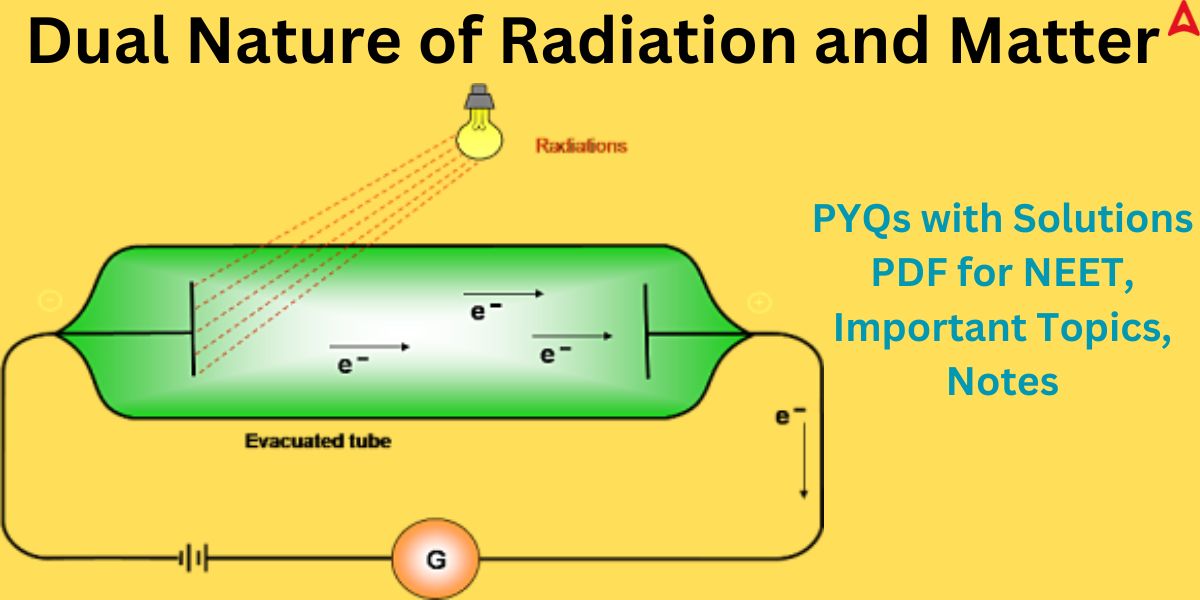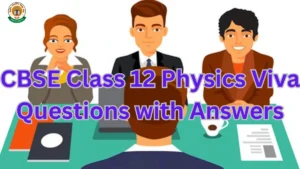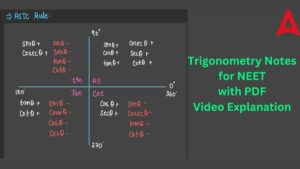Dual Nature of Radiation and Matter PYQs: The previous year’s questions of the chapter Dual Nature of Radiation and Matter will not only help students in solving the CBSE board exam’s question paper but also the competitive exams questions like NEET UG. This chapter forms the foundation for understanding the dual nature of light and matter. The discovery of the dual nature of matter and radiation is relatively recent. There is, according to physicists and scientists, yet more to learn about the dual nature of matter and radiation. Due to this, examiners target this section very much in the exam. To help students learn this chapter thoroughly, our Physics faculty has made a dedicated video solving previous year’s questions. The PDF of those important questions along with their answers is given below in this article.
Dual Nature of Radiation and Matter PYQs
The dual nature of radiation and matter previous year questions cover many different themes revolving around this concept. The questions are centered around the concepts like the Photoelectric Effect, De Broglie Hypothesis, Heisenberg’s Uncertainty Principle, etc. These concepts form one of the major sections of the modern physics. As modern physics has one of the highest weightage in the physics section of the NEET exam, understanding its core concept will not only help students solve complex questions but also crack the examination with flying colors.
Important Questions of Dual Nature of Radiation and Matter Class 12
Some of the important questions on this topic for Class 12 examination is given below. Questions on these patterns in different mark-segment is asked in various class 12 examinations. Students must go through the video explanation and PDF given below to understand the core concepts and answer these questions.
-
What is the photoelectric effect and how does it explain the dual nature of light?
-
Describe the Compton effect and how it supports the particle-like nature of light.
-
Explain the concept of wave-particle duality and its implications for our understanding of electromagnetic radiation.
-
Discuss the importance of the dual nature of light in various fields, such as physics, chemistry, and technology.
-
What are some recent experiments or observations that further explore the dual nature of light or other forms of electromagnetic radiation?
- Calculate the de Broglie wavelength of an electron with a given momentum.
- Apply the Compton wavelength formula to determine the change in wavelength of scattered X-rays.
- Describe the experimental setup and observations of the photoelectric effect.
- Explain how the Davisson-Germer experiment provided evidence for the wave nature of electrons.
- Explain the application of electron microscopy in light of the dual nature of matter.
Important Topics of Dual Nature of Radiation and Matter Class 12 for NEET
Before starting to prepare any given lesson, it is important to go through the important topics relevant in that chapter for the examination. As per the past trends, most of the times, questions on some topics are asked again and again. Preparing only these topics help students save time and increase efficiency. Some of the important topics of the Dual Nature of Radiation and Matter is given below.
-
Dual Nature of Radiation
-
Photoelectric Effect; Experimental study of Photoelectric effect; Einstein’s Photoelectric equation – Particle nature of light
-
Hertz and Lenard’s Observations
-
Matter waves – Wave nature of particles, and de Broglie relation
Let us understand some of these topics in detail by going through its notes.
Dual Nature of Radiation and Matter
The many optical phenomena, such as polarization, scattering, diffraction, interference, reflection, and refraction, are already familiar to us. We now know that light is a particle as well as a wave. They are hence referred to as dual nature radiation. A substance may exhibit or possess a wave or particle character. Additional experiments have been carried out to support this theory. At first, the particle nature of matter and light was used to explain their qualities. Among the early developments that affected this were the corpuscular theory of light and other things. Subsequently, it was discovered through experimentation that matter does in fact have wave characteristics. Because of this, matter is said to have dual nature, meaning it possesses both particle and wave qualities.
Dual Nature of Matter and Radiation Class 12
The dual nature of Matter and Radiation is a crucial chapter in the NCERT class 12 Physics book. This chapter features at unit number 11 in the NCERT class 12 Physics. This chapter covers many important concepts related to the duality of both light and matter. From the Photoelectric Effect to the Davisson-Germer experiment, all important observations have been highlighted in this chapter. This chapter has a high weightage in both NEET and board exams. Looking at its significance, we have presented top questions and PYQs on this chapter for both board exam and NEET exam.
Previous Year Questions on Dual Nature of Matter NEET
The questions on Dual Nature is always asked in the NEET exam paper. Many a times, its questions are asked both in the Chemistry as well as the Physics section. Every year, around 2-3 questions (4%-6% of total sectional questions) comes from this concept. Due to this, it is important to solve PYQs of this chapter to master different type of question patterns. Some of the previous year questions on Dual Nature of Matter and Radiation for the NEET exam is highlighted hereunder.
Q1. On a photosensitive substance, light with a frequency of 1.6 times the threshold frequency is incident. When the intensity doubles and the frequency is cut in half, the photocurrent becomes
- doubled
- quadrupled
- halved
- zero
Answer: (4) zero
Q2. The threshold wavelength for a metal with a work function of W0 is λ. What wavelength is the threshold for a metal with a work function of 2W0?
- λ/4
- 2λ
- λ/2
- 4λ
Answer: (3) λ/2
Q3. On a photosensitive metal, incident radiation with frequency v occurs. What is the maximal photoelectrons’ kinetic energy when the incident radiation frequency is doubled?
- 4E
- 2E
- E – hν
- E + hν
Answer: (4) E + hν
Q4. The stopping potential V0 for photoelectric emission from a metal surface is plotted along with the y-axis and frequency v of incident light along the x-axis, then the Planck’s constant is given by
- product of the slope of the line and charge on the electron
- intercept along y-axis divided by the charge on the electron
- product of the intercept along x-axis and mass of the electron
- the slope of the line
Answer: (1) product of the slope of the line and charge on the electron
Q5. Which of the following statements is true regarding the photoelectric experiment?
- The stopping potential increases with the increase in the intensity of incident light.
- The photocurrent increases with the intensity of light.
- The photocurrent increases with the increase in frequency
- All of the above
Answer: (2) The photocurrent increases with the intensity of light.
Q6. Determine the electron’s de Broglie wavelength, given its kinetic energy of 5 eV.
- 5.47 Å
- 2.7 Å
- 5.9 Å
- None of the above
Answer: (1) 5.47 Å
Q7. If a proton and an α particle are driven by the same potential difference, what is the ratio of their de Broglie wavelengths?
- 3√2: 1
- 3:2
- 2√2: 1
- 2: 1
Answer: (3) 2√2: 1
Q8. Which of the following physical processes can provide the free electrons with the minimal energy needed for the electron emission from the metal surface?
- Field emission
- Thermionic emission
- Photoelectric emission
- All of these
Answer: (4) All of these
Q9. If the K.E of the free electron is doubled then by what factor will the de Broglie wavelength change?
- ½
-
- 2
-
Answer: (2)
Q10. What determines the maximal electron reaction velocity with the collector in the photoelectric effect?
- Frequency of incident radiation alone
- The potential difference between the emitter and the collector
- The work function of metal
- All of these
Answer: (4) All of these
Q11. Which of the following scientist correctly identified the quantization of electric charge?
- R.A. Millikan
- Wilhelm Rontgen
- William Crookes
- J.J. Thomson
Answer: (1) R.A. Millikan
Dual Nature of Radiation and Matter PYQ NEET PDF
The PDF of NEET PYQs on Dual Nature of Radiation and Matter is given in the PDF form below. By going through this PDF, students will have a better grasp on different question pattern.
Dual Nature of Radiation and Matter PYQ NEET PDF with Solutions
Dual Nature of Radiation and Matter PYQ With Solutions Video
Our expert NEET Physics faculty at Adda 247 have created a dedicated video covering questions on all the important concepts of this chapter. Along with this, the NCERT review of the dual matter unit has also been done for the NEET point of view so that students do not miss any important detail.











 Physics Investigatory Project Class 12 T...
Physics Investigatory Project Class 12 T...
 CBSE Class 12 Physics Viva Questions wit...
CBSE Class 12 Physics Viva Questions wit...
 Trigonometry Notes for NEET, Download PD...
Trigonometry Notes for NEET, Download PD...














